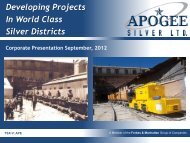Pulacayo Project Feasibility Study - Apogee Silver
Pulacayo Project Feasibility Study - Apogee Silver
Pulacayo Project Feasibility Study - Apogee Silver
Create successful ePaper yourself
Turn your PDF publications into a flip-book with our unique Google optimized e-Paper software.
<strong>Pulacayo</strong> 1 000 t/d Phase I <strong>Feasibility</strong> <strong>Study</strong> - NI 43-101 Technical Report<br />
090644-3-0000-20-IFI-100<br />
13.1.3 Bulk Density<br />
Two rock samples were selected from drill core samples for in-place bulk densities. Each<br />
sample was weighed, waxed and re-weighed, then immersed in water to determine volume of<br />
the sample. The in-place bulk density of the sample ranged from 2.2 t/m 3 (-73.5 #) to 3.4 t/m 3<br />
(-85 #).<br />
13.1.4 Leach Tests<br />
<strong>Silver</strong> Minerals in the ore were not amenable to leaching, even at the fine grind size. The<br />
silver extraction was extremely poor at the fine grind size of 150 µm, less than 20%,<br />
indicating that silver was not present in the ore in the native form. The NaCN and lime<br />
consumptions were high in the leach tests.<br />
A representative sample of the solid was submitted for determination of silver content by fire<br />
assay technique.<br />
13.1.5 Gravity Concentration Tests<br />
A gravity test was performed to determine the potential of recovering silver and other sulfide<br />
minerals by gravity concentration. A 2 kg sample was stage ground to P100 of 48 # (0.297<br />
mm) and processed over a Deister table. The Deister concentrate was re-processed on a<br />
Gemini table.<br />
The results indicated that the sample was not amenable to gravity concentration for silver<br />
recovery since the recovery of silver minerals was only 17% in the Gemini concentrate.<br />
13.1.6 Flotation Tests<br />
13.1.6.1 Grindability<br />
A grind study was initiated to determine the laboratory grind time vs. particle size relationship.<br />
The grind time requirement to achieve a P80 of 150 # (104 µm) was determined from the<br />
grind data, this being 20 minutes for the composite sample.<br />
13.1.6.2 Bench Scale Open Circuit Flotation Tests<br />
Bench scale open circuit flotation tests using the composite samples was performed using<br />
the flotation reagent suite developed for the San Cristobal <strong>Project</strong>. The flotation process<br />
consisted of grinding the ore with lime (pH > 8) and ZnCN followed by conditioning the<br />
ground pulp with more ZnCN, AP238 collector, sodium isopropyl xanthate (SIPX) and<br />
frother, methyl isobutyl carbinol (MIBC). The lead minerals were floated and the rougher<br />
concentrate was cleaned once. The lead rougher tails were conditioned with lime and copper<br />
sulfate and zinc rougher concentrate was collected using SIPX and MIBC. The zinc rougher<br />
concentrate was again cleaned once.<br />
The overall silver recovery in the lead and rougher concentrates was 97.1%.<br />
The lead cleaner concentrate recovered 2.8% of the weight, 84.6% of lead, 3.1% of zinc and<br />
46.9% of silver. The lead concentrate assayed 60.8% Pb, 4.22% Zn and 8,440 g/t Ag.<br />
TWP Sudamérica S.A. Av. Encalada 1257 Of. 801, Santiago de Surco Lima 33, Perú (51-1) 4377473<br />
Page 99



